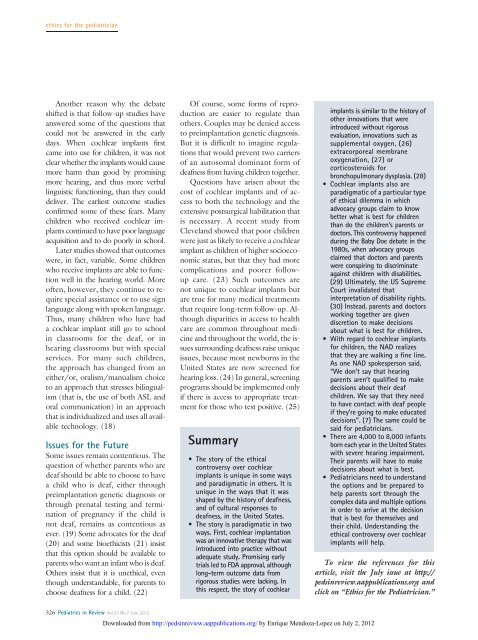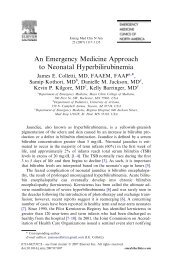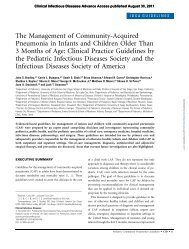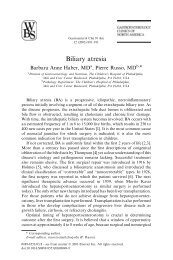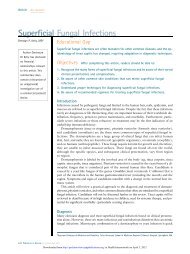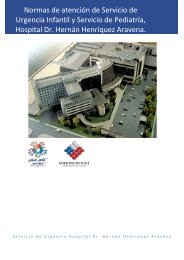An 11-year-old Girl Who Has Left Leg Pain
An 11-year-old Girl Who Has Left Leg Pain
An 11-year-old Girl Who Has Left Leg Pain
You also want an ePaper? Increase the reach of your titles
YUMPU automatically turns print PDFs into web optimized ePapers that Google loves.
ethics for the pediatrician<strong>An</strong>other reason why the debateshifted is that follow-up studies haveanswered some of the questions thatcould not be answered in the earlydays. When cochlear implants firstcame into use for children, it was notclear whether the implants would causemore harm than good by promisingmore hearing, and thus more verballinguistic functioning, than they coulddeliver. The earliest outcome studiesconfirmed some of these fears. Manychildren who received cochlear implantscontinued to have poor languageacquisition and to do poorly in school.Later studies showed that outcomeswere, in fact, variable. Some childrenwho receive implants are able to functionwell in the hearing world. Moreoften, however, they continue to requirespecial assistance or to use signlanguage along with spoken language.Thus, many children who have hada cochlear implant still go to schoolin classrooms for the deaf, or inhearing classrooms but with specialservices. For many such children,the approach has changed from aneither/or, oralism/manualism choiceto an approach that stresses bilingualism(that is, the use of both ASL andoral communication) in an approachthat is individualized and uses all availabletechnology. (18)Issues for the FutureSome issues remain contentious. Thequestion of whether parents who aredeaf should be able to choose to havea child who is deaf, either throughpreimplantation genetic diagnosis orthrough prenatal testing and terminationof pregnancy if the child isnot deaf, remains as contentious asever. (19) Some advocates for the deaf(20) and some bioethicists (21) insistthat this option should be available toparents who want an infant who is deaf.Others insist that it is unethical, eventhough understandable, for parents tochoose deafness for a child. (22)Of course, some forms of reproductionare easier to regulate thanothers. Couples may be denied accessto preimplantation genetic diagnosis.But it is difficult to imagine regulationsthat would prevent two carriersof an autosomal dominant form ofdeafness from having children together.Questions have arisen about thecost of cochlear implants and of accessto both the technology and theextensive postsurgical habilitation thatis necessary. A recent study fromCleveland showed that poor childrenwere just as likely to receive a cochlearimplant as children of higher socioeconomicstatus, but that they had morecomplications and poorer followupcare. (23) Such outcomes arenot unique to cochlear implants butare true for many medical treatmentsthat require long-term follow-up. Althoughdisparities in access to healthcare are common throughout medicineand throughout the world, the issuessurrounding deafness raise uniqueissues, because most newborns in theUnited States are now screened forhearing loss. (24) In general, screeningprograms should be implemented onlyif there is access to appropriate treatmentfor those who test positive. (25)Summary• The story of the ethicalcontroversy over cochlearimplants is unique in some waysand paradigmatic in others. It isunique in the ways that it wasshaped by the history of deafness,and of cultural responses todeafness, in the United States.• The story is paradigmatic in twoways. First, cochlear implantationwas an innovative therapy that wasintroduced into practice withoutadequate study. Promising earlytrials led to FDA approval, althoughlong-term outcome data fromrigorous studies were lacking. Inthis respect, the story of cochlearimplants is similar to the history ofother innovations that wereintroduced without rigorousevaluation, innovations such assupplemental oxygen, (26)extracorporeal membraneoxygenation, (27) orcorticosteroids forbronchopulmonary dysplasia. (28)• Cochlear implants also areparadigmatic of a particular typeof ethical dilemma in whichadvocacy groups claim to knowbetter what is best for childrenthan do the children’s parents ordoctors. This controversy happenedduring the Baby Doe debate in the1980s, when advocacy groupsclaimed that doctors and parentswere conspiring to discriminateagainst children with disabilities.(29) Ultimately, the US SupremeCourt invalidated thatinterpretation of disability rights.(30) Instead, parents and doctorsworking together are givendiscretion to make decisionsaboutwhatisbestforchildren.• With regard to cochlear implantsfor children, the NAD realizesthat they are walking a fine line.As one NAD spokesperson said,“We don’t say that hearingparents aren’t qualified to makedecisions about their deafchildren. We say that they needto have contact with deaf peopleif they’re going to make educateddecisions”. (7) The same could besaid for pediatricians.• There are 4,000 to 8,000 infantsborn each <strong>year</strong> in the United Stateswith severe hearing impairment.Their parents will have to makedecisions about what is best.• Pediatricians need to understandthe options and be prepared tohelp parents sort through thecomplexdataandmultipleoptionsin order to arrive at the decisionthat is best for themselves andtheir child. Understanding theethical controversy over cochlearimplants will help.To view the references for thisarticle, visit the July issue at http://pedsinreview.aappublications.org andclick on “Ethics for the Pediatrician.”326 Pediatrics in Review Vol.33 No.7 July 2012Downloaded from http://pedsinreview.aappublications.org/ by Enrique Mendoza-Lopez on July 2, 2012


